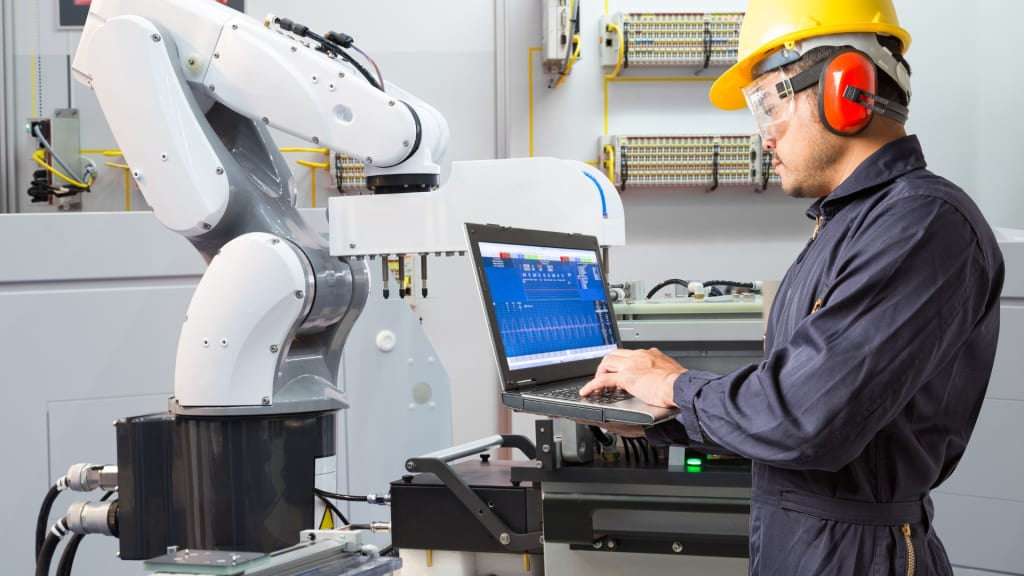
Industrial Robotics Market Surges Toward $55.19 Billion by 2033
Share

The global industrial robotics market will reach $55.19 billion by 2033, rising from $28.11 billion in 2024. This impressive growth, at a 7.79% CAGR, reflects accelerating automation and technological innovation across industries.
Manufacturers are embracing robots to boost precision, efficiency, and workplace safety. From automotive to pharmaceuticals, robotics is transforming production lines and redefining competitiveness worldwide.
Automation and AI Reshape Manufacturing
Automation adoption continues to rise as companies seek better productivity and reliability. Industrial robots now handle complex tasks like welding, painting, and assembly.
AI and machine learning enhance robots with adaptive capabilities. These technologies help factories reduce downtime, maintain quality, and optimize performance.
Moreover, smart sensors and the Internet of Things (IoT) connect robots to digital ecosystems. This connectivity supports predictive maintenance and real-time monitoring across production floors.
Collaborative Robots Drive Flexibility and Safety
Collaborative robots, or cobots, are gaining momentum across industries. They safely work beside humans, improving flexibility and ergonomics on assembly lines.
The International Federation of Robotics predicts cobots will represent 34% of all robot sales by 2025. This rapid adoption highlights a shift toward human-machine collaboration in modern factories.
Key Growth Drivers Fueling Market Expansion
1. Automotive Industry Leads Adoption
The automotive sector continues to lead in robot deployment. Manufacturers like Volvo and BMW rely on thousands of robots for welding and painting.
These systems ensure consistent quality and reduce human exposure to hazardous materials. Continuous investment in robotic innovation strengthens production accuracy and efficiency.
2. 3D Printing Integration Expands Use Cases
Robots are increasingly paired with 3D printing systems. This combination allows the creation of complex parts using metals and composites.
For example, ADDitec’s AMDroid robot supports high-speed metal deposition. Similarly, RIC Technology’s robotic printer enables automated construction of large-scale structures.
3. Industry 4.0 Accelerates Smart Manufacturing
Industry 4.0 connects robots with digital control systems. Companies like KUKA and ABB are developing advanced robots that combine strength with intelligence.
Partnerships, such as Figure and BMW’s humanoid robot project, show how automation is evolving toward fully digital, data-driven manufacturing ecosystems.
Challenges Facing the Industrial Robotics Market
High Initial Costs Limit SMEs
Many small and medium-sized companies struggle with upfront costs. Expenses include installation, calibration, and ongoing maintenance.
Although automation pays off long-term, high setup costs can slow adoption in cost-sensitive markets.
Skill Gaps Restrict Rapid Deployment
A shortage of skilled robotics professionals remains a major obstacle. Many organizations lack trained staff to program and maintain advanced systems.
To close this gap, companies are investing in workforce development and education partnerships.
Regional Market Highlights
United States
The U.S. robotics market grows as manufacturers embrace Industry 4.0 and cobots. Government incentives support modernization and efficiency, yet labor shortages persist.
United Kingdom
UK industries adopt robotics in automotive and pharmaceuticals. Cobots boost productivity, but high costs and workforce retraining challenges remain.
China
China leads in robotics production and adoption under the “Made in China 2025” initiative. Strong government support drives growth, though integration challenges continue.
United Arab Emirates
The UAE accelerates automation in logistics and construction. Vision 2021 promotes digital transformation, but high investment requirements still limit adoption.
Market Segmentation and Key Players
Industries: Automotive, Electronics, Metal and Machinery, Chemicals, Food, and Life Sciences.
Key Companies: KUKA, ABB, Fanuc, Panasonic, iRobot, Intuitive Surgical, Stryker.
These companies focus on AI-driven innovation, strategic partnerships, and expanding applications to maintain global competitiveness.
Future Outlook: Smarter, Greener, and More Connected
The future of industrial robotics looks bright. Cobots will become more common, helping smaller manufacturers automate safely.
AI and IoT will enable predictive analytics and energy-efficient automation. Sustainability will drive design changes toward low-power, eco-friendly systems.
Emerging economies in Southeast Asia, the Middle East, and Latin America will provide new opportunities as industries modernize.
In short, industrial robotics is entering a new era—faster, smarter, and more human-centric than ever before.
